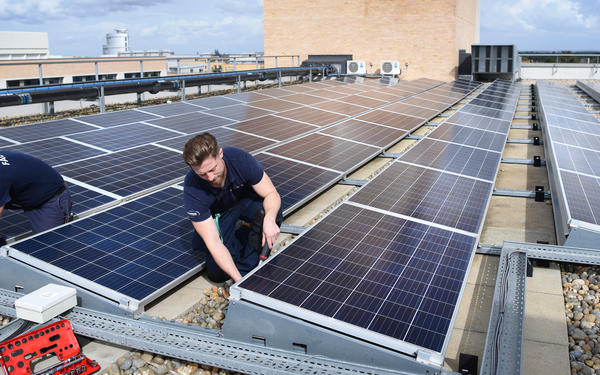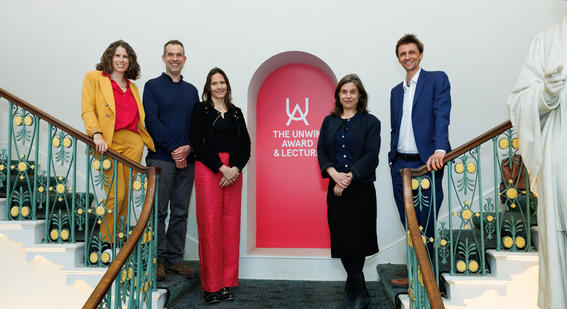Cutting our energy use and emissions
Everything we can do to reduce our energy use and switch to greener energy sources has an impact. Our Property Environment Manager, Peter Lumb, explains our science-based targets and what we’re doing to reduce our energy use and related emissions.

We are committed to reducing our environmental impact across all areas of our operations. Part of my job is to help us implement a range of energy and emissions savings activities to help achieve that. In our first financial year as Cambridge University Press & Assessment (2021-22) we reduced our UK electricity and gas emissions by 7 percent, but we’ve got a lot more to do to reach absolute carbon zero on all energy-related emissions by 2048 (scopes 1 & 2), in line with our University’s goal.
Science-based targets
As we are part of the University of Cambridge, we want to be rigorous in our approach to carbon reduction and showing our progress towards carbon zero. We manage our emissions via the world’s most widely used greenhouse gas accounting standards, the GHG (Greenhouse Gas) Reporting Protocol – Corporate Standard. This has three areas or scopes:
scope 1 direct emissions such as onsite combustion of fossil fuels (e.g. natural gas for heating)
scope 2 indirect emissions such as the purchase of electricity
scope 3 other indirect emissions across the entire value chain such as from purchased products and services, business travel, and waste.
We set an interim target of a 72 percent reduction in Scope 1 & 2 (energy related) emissions by 2030 against a baseline of 2018-19. Science-based targets for scope 3 are in development and will be reviewed by our governance boards in 2023.
Our efforts to meet our Scope 1 & 2 target will require work across a number of areas. Here is a summary of some of the action already happening:
Energy efficiency
Improving our energy efficiency is a big task, made up of a number of initiatives. For instance, we’ve been replacing lighting across our estate with more efficient LEDs. One recent example is the replacement of halogen floodlighting with LEDs at our Cass sports centre in Cambridge. The new lighting is 54% more efficient so will cut our energy-related carbon emissions for our University Printing House site by 1 percent. The amount of carbon dioxide emissions a year saved, 2.29 tonnes, would fill an estimated 21,468 footballs.
We’re also making sure existing equipment works correctly. For instance, we’ve identified some faults in sensors in our Triangle building that adjust lighting based on movement, to use energy smartly, so are working to fix this. Across the road, in University Printing House, we’ve improved air-conditioning timer settings to avoid wasting energy when meeting rooms are not in use.
We’re also looking at opportunities to use space more efficiently in existing buildings as well as set high standards when we relocate or choose new properties. This has the potential to have a big impact on reducing our energy use and carbon emissions.
Switching energy sources
We are working to replace gas-fired heating with electric in the UK as this can offer immediate gains in reducing our carbon emissions. Three projects have already been completed. A gas boiler in one of our office buildings has been converted to electric, another in one of our warehouses has been replaced with an air-source heat pump; and we’ve used a kitchen refit in one of our distribution centres as an opportunity to replace gas cooking equipment with electric alternatives.
The carbon-savings will get even better with time, as the UK’s National Grid turns towards more and more renewable sources. In the meantime, we are supporting renewable energy by completing a switch to 100 percent certifiable renewable electricity supplies for our UK premises.
Renewable energy on our own estate is another opportunity. We already have rooftop photovoltaic panels on five of our buildings in Cambridgeshire and we’re exploring more opportunities.
Data-driven decisions
Data from monitoring our energy use is helping us to make better decisions. For instance, analysis of energy meter data at one of our sites identified around 6kW of excess energy use – equivalent to nine vacuum cleaners or 60 fridges being left switched on. Making adjustments to building management systems is also helping us make further energy savings.
At the moment, we have better information for the UK than other locations. This is changing as a network of colleagues are now gathering data to help us understand our emissions around the world, where the opportunities and challenges are different to the UK.
Changing behaviour
Switching off the lights when we leave a meeting room or our screens when we leave our desks may seem like small things, but taken together, all actions like this add up to reduce our energy consumption. We’re rolling out training to our colleagues around the world so they can support our efforts, which also prompts us to think about the technology we use, our corporate travel and journeys to work, and helping colleagues make good purchasing choices.
Earth Hour 2023
Our lights went off for Earth Hour 2023 on three of our buildings in Cambridge - the Pitt building, the former home of the Press, our bookshop in Cambridge city centre and on the tower on Triangle, a local landmark. Around the world, our colleagues found ways to join in Earth Hour, spending 60 minutes doing something positive for our planet. It is one of the many ways colleagues can join in our journey to our zero carbon target.

We recognise the climate emergency and our responsibility to act. Our role as a leader in global education and research is to inform and progress action and debate around the world’s most pressing challenges, including the environment and climate change.
We are committed to reducing our environmental impact across all areas of our operations. We work to support our suppliers to share our ambitions for a carbon zero supply chain, while promoting our environmental ambitions to our people, customers and partners around the world.
Find out more about our approach to sustainability.






